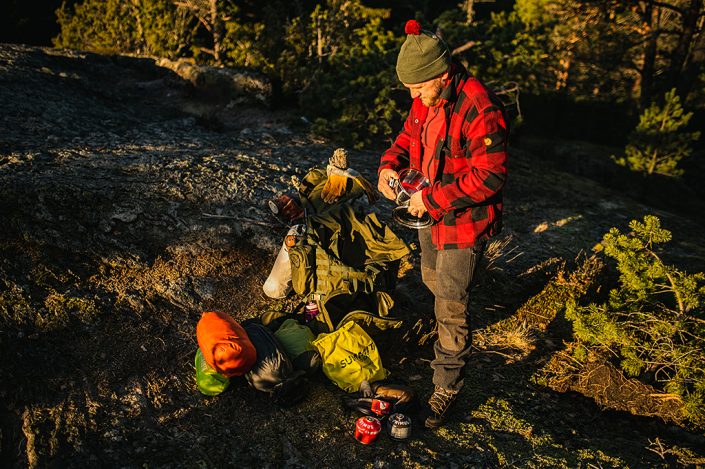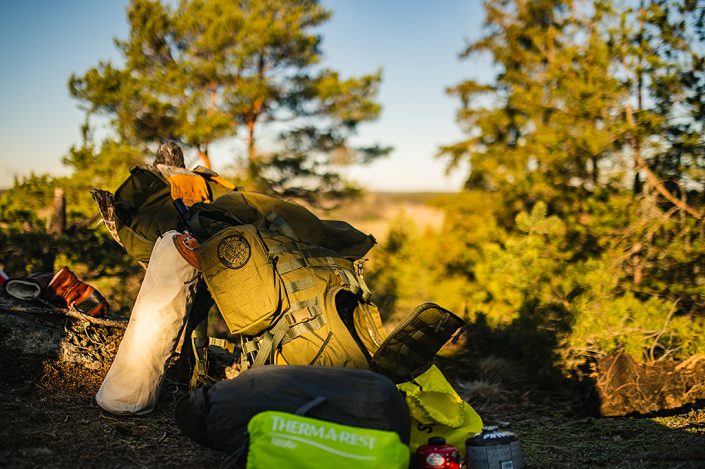

How to pack a backpack the right way for a hike
Have you just purchased a backpack and are you thinking of how to pack it correctly? In this article we will tell you how to pack your backpack, so that it sits comfortably on your back and all your gear is easily accessible.
 Backpacks come in many different sizes and shapes, but there are a few basic principles to packing them.
Backpacks come in many different sizes and shapes, but there are a few basic principles to packing them.
Outdoor expert Mikko’s tips for packing a backpack for a hike
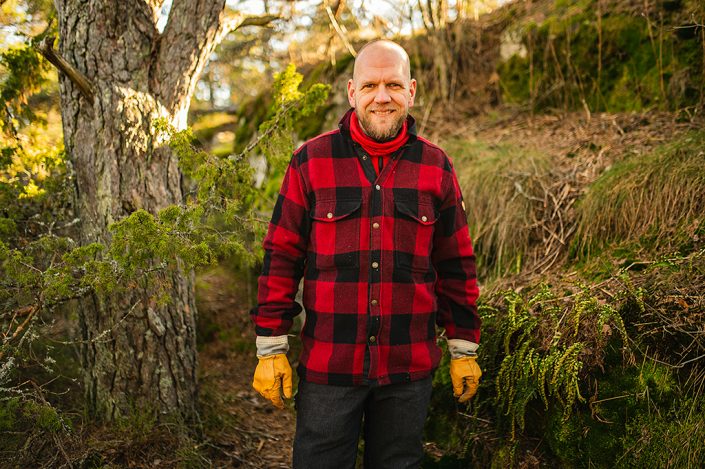 Mikko works as an outdoor specialist at our Turku Hansa shop. Mikko has almost 20 years of experience with helping hikers, and we’re certain that he is a familiar face to many of our customers. Mikko also acts as one of the outdoor experts for our Outdoor Guides.
Mikko works as an outdoor specialist at our Turku Hansa shop. Mikko has almost 20 years of experience with helping hikers, and we’re certain that he is a familiar face to many of our customers. Mikko also acts as one of the outdoor experts for our Outdoor Guides.
There is no single way to correctly pack a backpack, but there are a few guidelines that apply to all bags and backpacks.
The heaviest things should be packed closest to the back, right between the shoulder blades. The heaviest things in the backpack are usually the tent and the food. Lighter gear can be packed into the outer pockets of the backpack, things of medium weight go around the heavy gear.
 Dry bags ensure that important gear stays dry in any weather.
Dry bags ensure that important gear stays dry in any weather.
Some backpacks come with rain covers that can be worn over the backpack to protect the contents from getting wet. However, if you get caught out in a torrential downpour, some moisture usually does make it into the backpack, especially from the space between the cover and the wearer’s back. This is why everything that has to stay dry must be packed into waterproof dry bags. It is very important to keep clothes, sleeping bags, dried food, and other similar items safe from the rain. Another option is to use a single large dry bag with enough space for all the important items.
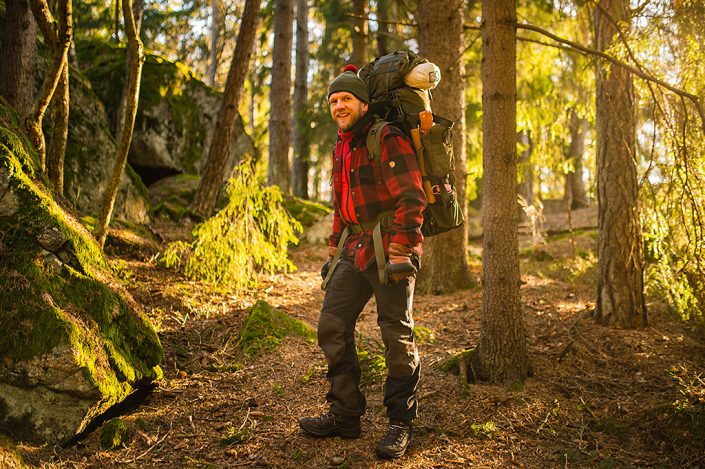 Mikko uses a Savotta Jääkäri XL backpack that has Savotta’s MOLLE attachment points for external pockets.
Mikko uses a Savotta Jääkäri XL backpack that has Savotta’s MOLLE attachment points for external pockets.
Personal preferences and the type of backpack used also influence the way you pack your backpack. You should think of what gear you might need to use while on the move. The fastest way to reach that gear is to store it in the side pockets. Are you going to cook lunch? Will you need to make some adjustments to your clothing if it starts to rain? Is it likely that you will need some smaller items (compass, knife, headlamp, lighter, notebook, hygiene products)?
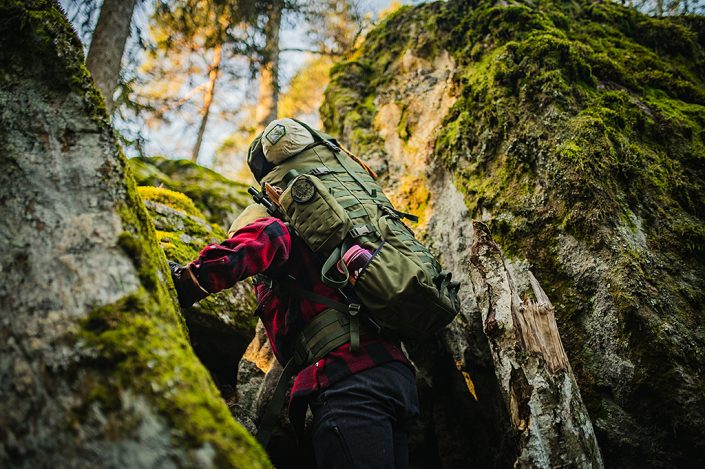 Rough terrain underlines the importance of packing the backpack correctly. The backpack should be balanced, and things shouldn’t hang loosely off its sides.
Rough terrain underlines the importance of packing the backpack correctly. The backpack should be balanced, and things shouldn’t hang loosely off its sides.
The backpack is balanced and comfortable to wear when its center of gravity is close to your bag. If the center of gravity is high it disrupts your balance when moving in rough terrain. A narrow backpack is also more agile when negotiating narrow places.
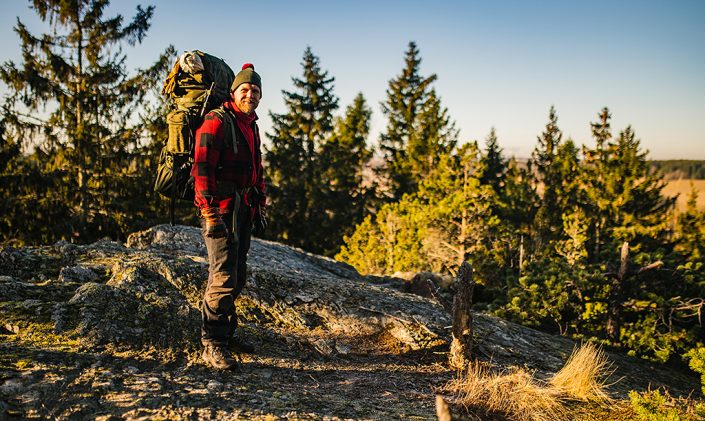 You know a backpack is packed correctly when it is not too heavy and you can comfortably wear it with a smile while hiking.
You know a backpack is packed correctly when it is not too heavy and you can comfortably wear it with a smile while hiking.
You can practice packing your backpack at home. You can then walk in nearby woods and set up camp just for practice. Everyone develops their own way to pack their backpack that will then change according to their destination, weather, terrain, and other variables.
What to pack for a hike?
Everyone is always excited when going on their first hike. Have I packed everything I need? Do I have the right gear? What if something breaks while on the hike? Those are the questions many go through in their head.
You should keep an eye on the weight of the backpack. In the beginning you will easily go overboard, packing all sorts of things along “just in case”. It will take a few hikes to notice what gear you really need, but to start out with there will probably be a lot of “useless” stuff in your backpack. You can simplify the process by making a packing list. After your first hike you can can cross off things that turned out to be unnecessary. A first aid kit and similar safety items should not be removed from the list even though you didn’t need them. You should always have them with you.
An example of a packing list for a hike when the ground is thawed:
Clothes to wear:
- merino wool underwear
- hiking socks
- hiking pants
- a “breathable” shirt and jacket (you can often get by without a coat when it’s warm)
- hiking boots
- headgear and gloves according to the weather
- trekking poles
Pocket, backpack side pocket, map pouch, and other quick access storage:
- map and compass
- a drinking bottle or a bladder
- knife
- sunglasses
- fire making kit
- toilet paper
- phone
- camera
- GPS
- headlamp (not needed in the Arctic during the midnight sun season)
Backpack:
- shelter (tent, hammock, tarp)
- sleeping pad
- sleeping bag (in a waterproof compression bag, or without a packing bag to fill the space around other gear)
- pillow (in a drybag or a drybag as a pillow)
- sleeping bag liner (protects the backpack from getting dirty and lends extra warmth)
- a change of underwear + long underwear
- a few pairs of hiking socks
- warm clothing, such as a light down jacket
- waterproof shell clothing (within quick reach)
- food (breakfast, lunch, dinner, supper, snacks)
- stove + fuel (gas, alcohol, wood, or petrol camping stove)
- pots and kettle + coffee/tea
- utensils (a dish and a spoon is usually enough)
- dish washing brush (detergent is rarely needed, make sure its nature friendly brought along)
- guksi
- camp shoes
- first aid kit and personal medicine
- a mosquito net over your hat and/or mosquito repellant
- personal hygiene products (soap, toothbrush and paste, toilet paper, sunblock etc.)
- repair kit (needle + thread, packing straps, tape, a few zip ties and paracord)
Other possible gear:
- fishing gear
- photography gear
- note taking and drawing equipment
- book(s), either paper or e-book
As you can see, there is a lot of gear to pack for a hike, so you should think carefully of what you really need to bring along with you. You can make sure you don’t get carried away by weighing different options and monitoring the weight of the packed backpack. Ultralight backpackers might have backpacks as light as 10kg and under, but generally a backpack weights around 15 to 20 kg on longer hikes.
Mikko and everyone at the Scandinavian Outdoor wish you unforgettable hikes. If you have any questions you can contact our customer service or visit our store and speak with our experts!
Read more:
Posted: 23.3.2020Modified: 16.1.2025
